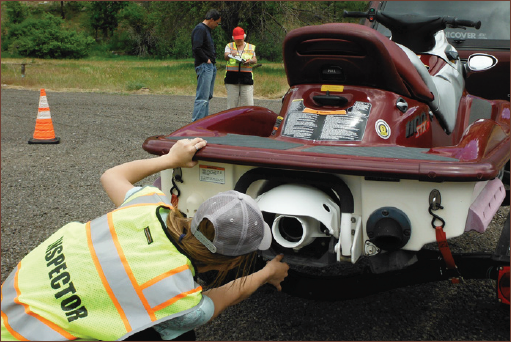Biology, Ecology and Management of Curlyleaf Pondweed (Potamogeton crispus)
Curlyleaf pondweed (Potamogeton crispus) is an aquatic invasive plant first reported in Montana in Lake County in 1973. Plants initiate growth before native species thereby crowding them out, dense mats of foliage inhibit recreational activity, and its subsequent decay in mid-summer can alter water oxygen levels. Curlyleaf pondweed commonly grows in ponds and slow moving rivers. Learning to identify curlyleaf pondweed and reporting it when found as well as preventing unintentional transfer from infested to non-infested waters is paramount.
Last Updated: 07/16by Hilary Parkinson & Jane Mangold, Department of Land Resources and Environmental Sciences, Montana State University; Craig McLane, Montana Fish, Wildlife, and Parks
PLANT BIOLOGY
Identification
Curlyleaf pondweed is an aquatic plant with alternately arranged leaves that are fairly stiff, 0.75-3.2 inches long by 0.1-0.5 inch wide, and reddish-brown to olive-green in color (Figure 1). A particularly distinctive feature is the leaf margins which are wavy, like a lasagna noodle, and minutely toothed (young leaves sometimes lack distinctive waviness). All leaves are submersed, but the upper leaves at the tip may be within an inch of the water surface. The inconspicuous, reddish-brown flowers emerge above the surface of the water in a spike. There are two native plants in Montana that may be mistaken for curlyleaf pondweed. See Speedy Weed ID on page 2 for tips to distinguish it from these plants.
FIGURE 1. Curlyleaf pondweed has wavy leaf margins and alternate leaf arrangement. (Jane Mangold, Montana State University)
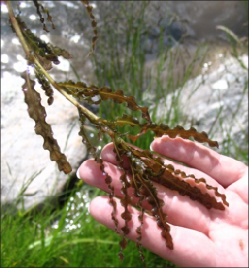
Speedy Weed ID
Think you’ve got curlyleaf pondweed? In Montana, curlyleaf pondweed could be mistaken for Richardson’s pondweed and white-stemmed pondweed (Table 1 and Figure 2, page 3). To verify curlyleaf pondweed, you should be able to answer yes to all four questions below.
- Are the leaf margins wavy like a lasagna noodle (Figure 1, page 1) (young leaves sometimes lack distinctive waviness)?
- Are leaf margins minutely toothed (may need hand lens)?
- Are leaf tips round, not pointed?
- Are leaves alternate along entire stem (leaf arrangement is not opposite or in clusters of 3-4)?
If you only answered yes to some, or were unsure, refer to Table 1 for important characteristics to differentiate from the two look-a-like species, and refer to the drawings in Figure 2.
TABLE 1. Characteristics to distinguish curlyleaf pondweed from other look-a-like species in Montana.
Curlyleaf Pondweed
Potamogeton crispus
Richardson's Pondweed
Potamogeton richardsonii
White-stemmed Pondweed
Potamogeton praelongus
leaf length (inches) 0.75-3.2 0.8-4 2.4-7.9 leaf tip rounded pointed pointed margins minutely toothed entire entire
margins wavy?yes(young leaves some- times lack waviness)
yes
yes
leaves clasping?yes(may not be promi- nent, often sessile)
yes
yesleaf arrangement alternate alternate alternate
stemstem slightly flattened, branched stem round, little branched stem round, little branched, tend to zig zag
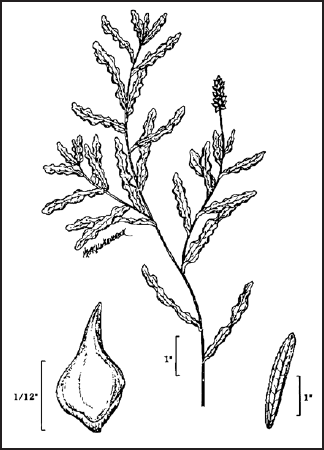
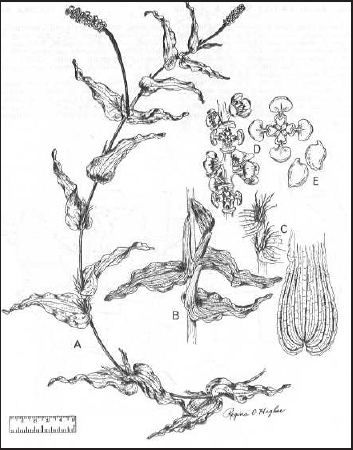

FIGURES 2 A-C. A. Curlyleaf pondweed. B. Richardson’s pondweed. C. White-stemmed pondweed. (A, C, USDA Plants Database; B, University of Wisconsin Stevens Point from USDA-Common Weeds of the United States)
Life History
The life cycle of curlyleaf pondweed differs from most aquatic plants. In the fall, starch containing structures, referred to as turions, germinate (Figure 3). The foliage that develops from these structures remains intact throughout winter under ice and snow. In early to mid-spring when water temperatures rise to 41°F (5°C), shoots form and plants develop roots. This growth is well in advance of native plant growth. In early summer, inconspicuous flower spikes form and emerge above the water surface. Flower formation occurs at the same time as turion formation, which is optimal at temperatures above 59°F and day lengths greater than twelve hours. Once formed, dormant turions sink to the floor of the water body and the existing foliage begins to decay. Turions break dormancy in the fall with decreasing daylight and temperature, or when temperatures are roughly less than 68°F and daylight is less than 11 hours.
FIGURE 3. Ungerminated turions (indicated by white arrows). (Washington Department of Ecology)


Current Status and Distribution
Curlyleaf pondweed is native to Eurasia. The earliest verified collection in North America was in Philadelphia in 1841, and it was confined to the Northeast prior to the 1900s. By 1950 it had spread to most of the U.S. and is now on the noxious weed list in Alabama, Connecticut, Maine, Massachusetts, Montana, Vermont and Washington. In Montana, it was first reported in Lake County in 1973 and was listed as a noxious weed in 2010. The map above shows water bodies with confirmed reports of curlyleaf pondweed in Montana, including the following counties: Broad- water, Cascade, Choteau, Deer Lodge, Flathead, Gallatin, Granite, Jeffer- son, Lake, Lewis & Clark, Madison, Powell, Ravalli, Sanders, and Valley. The highest reports per county come from Lake, Flathead, and Gallatin counties, but the plant is likely much more widespread than reported.
Curlyleaf pondweed is listed as a Priority 2B noxious weed in Montana, meaning the weed is abundant in Montana and widespread in many counties; management criteria are eradication or containment where less abundant. Management is prioritized by local weed districts.
ECOLOGY
Habitat
Curlyleaf pondweed grows in ponds, lakes, streams and rivers (Figure 4). It can tolerate a moderate current. It occurs from shore to depths of 18 feet and is most commonly found at depths of 3.2-10 feet. It can grow in a range of substrates from sandy to hard bottom, but it grows best in material that is neither too fine nor too coarse and with an organic matter of 10-25%. Curlyleaf pondweed is most common in alkaline, calcareous water. Its presence is often an indicator of eutrophic conditions, or water bodies with high levels of nitrogen, phosphorous and organic material.
Spread and Establishment Potential
The primary mode of spread from one water body to another is plant fragments containing turions on boat trailers and other recreational equipment. Curlyleaf pondweed may also be dispersed by waterfowl who consume the seeds. Within a water body, spread is primarily by turions. Turion production is prolific with a study in Minnesota finding turion density ranged from 725 to 2,713 turions per square meter. Curlyleaf pondweed seed germination is believed to be low. A study in South Africa found less than 0.1% of seed germinated.
FIGURE 4. Curlyleaf pondweed in pond near Bozeman, Gallatin County. (Jane Mangold, Montana State University)
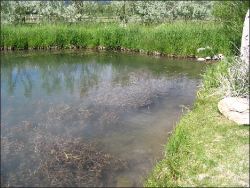
FIGURE 5. Curlyleaf pondweed forms dense mats by early summer. (Chris Evans, bugwood.org)
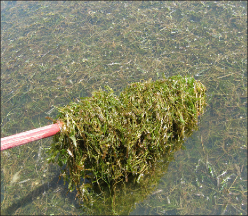
Establishment potential is enhanced by curlyleaf pondweed’s life history. Turions sprout in the autumn and remain alive under ice and snow. The ability of turions to initiate growth much earlier than native species gives them a competitive advantage as does their dormancy in mid- summer when native aquatic species growth and competition is highest.
Damage Potential
Profuse growth early in the season creates dense mats that inhibit boating and swimming and can shade and inhibit growth of native plants (Figure 5). Some studies have found that native plants don’t recover after curlyleaf pondweed dies back in mid-summer. Prolific growth of curlyleaf pondweed impedes water flow in irrigation canals, potentially impacting agricultural production. Prolific growth is also associated with depletion of nutrients which can be problematic for fisheries. The subsequent dieback and decay of curlyleaf pondweed depletes oxygen and is associated with algal blooms.
Curlyleaf pondweed provides some ecological benefits. Seeds are produced prolifically and can be a major food source for ducks and other waterfowl. In one study comparing a variety of aquatic plants, curlyleaf pondweed provided excellent habitat for a variety of macroinvertebrates for fish. While the production of fruit and foliage early in the year is to the detriment of other native aquatic species, it may improve early season habitat for aquatic animals.
MANAGEMENT ALTERNATIVES
Chemical control
Table 2 shows herbicides used for curlyleaf pondweed. Timing of chemical control is particularly important. Because curlyleaf pondweed grows early in the spring prior to growth of native aquatic vegetation, herbicide applications at this time can reduce impacts to non-target aquatic plants, most of which are still dormant. However, if temperatures are too low, curlyleaf pondweed won’t be actively growing so herbicides will not be as effective. Follow label recommendations, but apply at the lowest temperature range shown on the label. Herbicides may be applied to water only by applicators with an Aquatic Pest Control license.
TABLE 2. Herbicides for curlyleaf pondweed.
| Active ingredient | Trade Name | Notes |
| Diquat | Reward, Weedtrine-D | Acts in 7 days, limited drift |
| Endothall | Aquathol, Hydrothol 191 | Acts in 7-14 days, limited drift |
| Fluridone | Sonar A.S, Sonar SRP | Acts in 30-90 days, must be applied to whole lake |
Mechanical and Physical Control
Mechanical control options include raking and hand cutting. Activities should be done in spring to early summer to reduce or prevent turion formation, thereby interrupting the plant’s life cycle. As with other control options, raking and hand cutting will need to be repeated for many years, and then monitored thereafter to ensure the plant does not re-establish.
Raking appears to have been an effective measure at the East Gallatin Recreation Area in Bozeman, MT (Figure 6), improving conditions for swimming, boating and fishing. Over the course of three years, a large crew of volunteers raked and bagged the infestation. By the fourth year, the infestation was small enough to not warrant repeating, but the site will be monitored for a number of years and control implemented as needed.
FIGURE 6. Volunteers rake curlyleaf pondweed at the East Gallatin Recreation Area. (Hilary Parkinson, Montana State University)
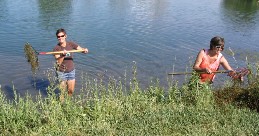
Physical control includes the use of benthic barriers, drawdowns, and dredging. Benthic barriers are light impermeable mats that are laid on the floor of the water body around docks and other high use areas to prevent plants from rooting. They are expensive and non-selective, but typically long lasting and effective. Drawdowns in the fall and early winter cause turions to freeze, thereby destroying them. Dredging, or the deepening of a water body, prevents light penetration at the deepest part, preventing plant survival. Drawdowns and dredging require extensive planning and permitting.
Biological Control
Grass carp are used in some areas of the United States, but this species has many drawbacks, including it being non-selective, feeding on other aquatic plants and destroying habitat. Grass carp are prohibited in Montana. No other biological controls are available at this time.
INTEGRATED WEED MANAGEMENT (IWM)
Preventing new infestations is a critical component to any integrated weed management plan, and is especially important for aquatic invasive species. Steps to follow to prevent the spread of plants like curlyleaf pondweed include: thoroughly rinsing any mud and debris from all equipment and wading gear and draining the water from your boat before leaving access areas; removing all plant fragments from the boat, propeller, and boat trailer; allowing boats or equipment to dry at least five days before transporting them to new bodies of water; not disposing of aquarium or water garden plants in other bodies of water, and sealing plants in a plastic bag and placing in the trash for disposal.
Water craft Inspection Stations
In an effort to reduce the spread of aquatic invasive species, Montana Fish, Wildlife & Parks (FWP), along with its partners, operate watercraft inspection stations throughout the state. Many aquatic invasive species can spread to other water bodies via overland transport. Inspection stations provide FWP an opportunity to reduce potential sources of aquatic invasive species, including curlyleaf pondweed turions, and provide valuable outreach to boaters and recreationists in Montana. These inspection stations operate from April or May through September and are located along major interstates entering Montana as well as key internal highway locations. There are also roving crews that move among water bodies throughout the state.
During the watercraft inspection process, the inspectors will conduct a short survey to gauge the risk of the vessel for transporting aquatic invasive species (Figure7). As an additional part of the survey, the inspector will assess the knowledge level of the recreationist and then subsequently provide them with additional information on aquatic invasive species. The last part of the process is a physical inspection of all exteriors of the watercraft and trailers as well as inspection of interior portions of watercraft capable of holding water or harboring aquatic invasive species such as bilge areas, livewells, bait buckets, anchors, and ropes.
Watercraft inspections also educate watercraft users on the risk of aquatic invasive species. More than half (53%) of all boaters that answered questions about their knowledge of invasive species say they learned at least a portion of what they know about aquatic invasive species from the watercraft inspection process.
In 2015, FWP performed 36,996 inspections with 8,040 (21.7%) out-of-state boats and 28,956 (78.3%) in-state boats. Many of these boats traveled long distances before entering Montana. For example, 104 boats were from Florida. These long travel distances provide enormous opportunities for new aquatic invasive species to move to Montana. Boats traveling locally or within Montana can potentially spread existing infestations to new water bodies as well.
FIGURE 7. Inspectors examining watercraft and interviewing recreationalists at Montana Fish, Wildlife, & Parks watercraft inspection station. (Craig McLane, Montana Fish, Wildlife, & Parks)
Once infested, management options depend on the stakeholders and how the water body is used. Benthic barriers are recommended around docks and other high use areas to reduce unintentional transfer of materials on boat trailers. Boat washing stations are recommended, especially at areas infested with this plant to prevent unintentional introductions to non-infested waters. Raking is recommended for smaller infestations and can be effective when coordinated with the community. Stakeholders and managers must weigh the impacts of herbicide on users, and other native aquatic species in the area, and herbicide use should be carefully coordinated by a long-term management plan.
ACKNOWLEDGEMENTS
The authors would like to thank Jill Allen, Brad Bauer, and Jennifer Parsons for reviewing this publication, and MSU Extension Publications for assistance with layout and design. Funding assistance provided by USDA-NIFA-AFRI (grant # 2014-70006-22554).
REFERENCES
Catling, P.M. and I. Dobson (1985) The biology of Canadian weeds. 69. Potamogeton crispus L. Canadian Journal of Plant Science 65:655-668.
Hill, B. H. and J. R. Webster. 1982. Aquatic macrophyte breakdown in an Appalachian river. Hydrobiologia. 89: 53-59.
Jian, Y., B. Li, J. Wang, and J. Chen. 2003. Control of turion germination in Potamogeton crispus. Aquatic Botany 75 (59-69).
Lesica, P. 2012. Manual of Montana Vascular Plants. Botanical Research Institute of Texas, Fort, Worth Texas.
Rogers, K. H. and C. M. Breen. 1980. Growth and reproduction of Potamogeton crispus in a South African lake. J. Ecol. 68: 561-571
Sastroutomo, S. S. 1981. Turion formation, dormancy, and germination of curlyleaf pondweed, Potamogeton crispus L. Aquat. Bot. 10: 161-173
Tobiessen, P. and Snow P.D. (1984) Temperature and light effects on the growth of Potamogeton crispus in Collins Lake, New York State. Canadian Journal of Botany 62:2822-2826.
Woolf, T.E. and J.D. Madsen. (2003) Seasonal biomass and carbohydrate allocation patterns in southern Minnesota curlyleaf pondweed populations. Journal of Aquatic Plant Management 41: 113-118.


